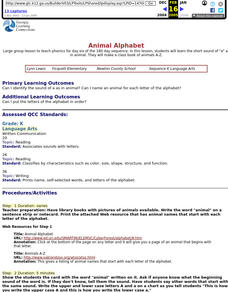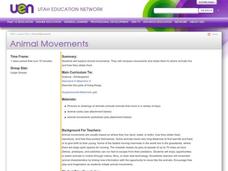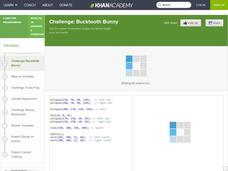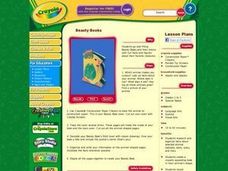Curated OER
Staying Warm-Keeping Cool
In this Internet research worksheet, students go to the indicated website and read about animal habitats. Students answer 6 questions.
Curated OER
Basic Units of Life
In this cells worksheet, students will review vocabulary words and information relating to the structure and function of plant and animal cells. This worksheet has 10 crossword puzzle questions, 6 multiple choice, 4 short answer...
Curated OER
Around-The-World-Zoo
Junior biologists design and maintain a website about a zoo by researching, classifying, and providing the correct habitats for the animals they choose to have in their zoo. This technology-based project can last over an entire semester...
Curated OER
All Ears for Adaptation
Students discuss different characteristics that enable animals to adapt to their environments. They work in pairs with one partner standing about one foot behind the other partner and cup their hands around their ears with palms forward....
Curated OER
Small
In this visual discrimination worksheet, students analyze the two pictures of animals. Students circle the picture in each row that is the smallest. There are 5 questions.
Curated OER
Animal Tracks
Students study animals. In this science lesson, students make plaster casts of animals that live in the area. Students identify the tracks.
Curated OER
Animal Alphabet
Students make a class animal book using the letters of the alphabet. They use a website imbedded in this plan to get pages with animals that begin with any of the 26 letters.
Curated OER
Animal Movements
Students will explore animal movements. They will compare movements and relate them to where animals live and how they obtain food.
Curated OER
Elementary Animal Classification
Students investigate eight basic animal groups, and identify the different groups through knowledge of animal characteristics, changes, and life cycles of each group.
Curated OER
Develop a Bird Feeder Watch List
Students explore biology by identifying animals on their school ground. For this bird species lesson, students create and utilize a simple bird feeder to attract birds near their classroom at which point they observe the color, size and...
Curated OER
Animal Top Trumps
Second graders evaluate different animals. In this animal parts lesson, 2nd graders create a game that compares animals based on five concepts- attack, defend, agility, speed and size.
Khan Academy
Challenge: Bucktooth Bunny
Practice creating and using variables by creating variables for the bunny's eyes and teeth in this JavaScript task. Use the slider above the number to see the power of using variables in your code.
Curated OER
Fun Activities Using Seeds
Students analyze the size, shape, and form of several different seeds. In this all about seeds lesson plan, students complete four activities involving characteristics of seeds. Students observe the seeds, record information about the...
Curated OER
Power Point Lesson Plan
Students create a multimedia animal research presentation based on the include criteria for both information and sideshow format. They follow directions on slide set-up from creating a slide to transitions and musical insertion.
Curated OER
Bird Brained?
Students identify general abilities that indicate animal cognitive intelligence. In this biology lesson, students create an intelligence testing challenge for ravens. They compare its ability to that of a crow.
Curated OER
Design a Plankton
Students explore animal and plant adaptation. In this ecosystems science lesson, students view websites to gain information about plankton and its interdependence within ecosystems. Students identify ways in which plankton has adapted...
Exploratorium
Disappearing Act
Crafty critters are camouflaged to escape predators, and crafty science pupils can construct a camouflage demonstration. They work with a partner to show that as a camouflaged animal moves, it becomes more visible.
Howard Hughes Medical Institute
Population Dynamics
Will human population growth always be exponential, or will we find a limiting factor we can't avoid? Young scientists learn about both exponential and logistic growth models in various animal populations. They use case studies to...
Curated OER
Animal Top Trumps
Young scholars use adjectives to construct sentences. In this english instructional activity, students play a card game based on Top Trumps. They use superlatives and comparatives during the game.
Curated OER
Beasty Books
Students, after researching and organizing facts about selected animals habitats, diets, sizes and lives, create a visually appealing book in their animal's shape. They record information assessed from their research in the books.
National Gallery of Canada
My Own Blanket
Invite your young artists to design blankets that express their own identities. Learners examine various pieces of art before brainstorming a few things that represent their identities. They use these ideas, in addition to symmetry and...
Howard Hughes Medical Institute
Human Impacts on Biodiversity
Have you always wanted to take your science class on an amazing field trip they will never forget? Now you can! Observe the wildlife in an African savanna through trail cameras with a five-part data analysis activity. Learners analyze...
Laboratory for Atmospheric and Space Physics
Polar Vortex Interactive
An interactive lesson places pupils as scientists who must learn why the ozone layer is being destroyed by analyzing the data from multiple satellites. The first analysis shows how UV is related to the ozone cycle. The second...
National Wildlife Federation
How Many Bison?
Math and science to the rescue! Some basic math concepts help scientists predict wildlife populations. Using tokens, groups simulate tagging a wildlife population. They then use proportions to estimate the population of the wildlife.

























